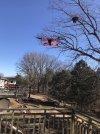This is sort of an add-hoc test that arose from my introductory post to the forum. Being a kind of red neck country bumpkin & the fact that an advertisement for the bird i bought had a "no license to fly" statement , I never even gave any other regs a thought....until I was jacked up in that post for flying out past what was any visual possibility.
A couple days ago I was flying in sky conditions that went from light grey clouds to light blue to dark blue. After flying a test pattern in all color schemes I have come to the conclusion that our birds should all be black.
The light grey color of my Mini SE got swallowed up by the grey clouds in 250 meters and after loosing sight of the thing, had to fly back to 200 m before it was easily sighted again.
Against the light blue, Not much better distance was achieved, 300-320 M and again had to fly back quit some distance before easy pick-out was noticed.
The dark blue sky was the best at 370 M but still not what I expected....
What I "expected" is what I watched that same day out my kitchen window while having morning coffee. That morning I watched a flock of ducks circling my neighbors field from a distance of 800 M or more and without aided vision I could make out the individual birds in flight. They weren't big by any stretch but they were very black & very visible . A sideways view of a duck is slightly larger than a drone but not much and these ducks were 800 M away and just above the horizon so were very much a side view for me.
So my conclusion was that the grey color of my drone was swallowed up by most any sky color we will fly in but those dark colored ducks are plainly visible from almost 3 times the distance.
A couple days ago I was flying in sky conditions that went from light grey clouds to light blue to dark blue. After flying a test pattern in all color schemes I have come to the conclusion that our birds should all be black.
The light grey color of my Mini SE got swallowed up by the grey clouds in 250 meters and after loosing sight of the thing, had to fly back to 200 m before it was easily sighted again.
Against the light blue, Not much better distance was achieved, 300-320 M and again had to fly back quit some distance before easy pick-out was noticed.
The dark blue sky was the best at 370 M but still not what I expected....
What I "expected" is what I watched that same day out my kitchen window while having morning coffee. That morning I watched a flock of ducks circling my neighbors field from a distance of 800 M or more and without aided vision I could make out the individual birds in flight. They weren't big by any stretch but they were very black & very visible . A sideways view of a duck is slightly larger than a drone but not much and these ducks were 800 M away and just above the horizon so were very much a side view for me.
So my conclusion was that the grey color of my drone was swallowed up by most any sky color we will fly in but those dark colored ducks are plainly visible from almost 3 times the distance.












